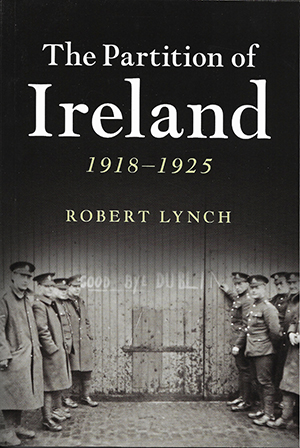The partition of Ireland 1918–1925
Published in Book Reviews, Book Reviews, Issue 1 (January/February 2020), Reviews, Volume 28ROBERT LYNCH
Cambridge University Press
€24
ISBN 9780521189583
Reviewed by: Martin Mansergh
Martin Mansergh is a former politician and NI adviser.
 There is a growing literature on the border and partition, stimulated as much by their central role to date in the drama of Brexit as by the looming centenary. This book has the stated ambition of putting Irish historians as a class to rights, including those closer to Ulster unionism.
There is a growing literature on the border and partition, stimulated as much by their central role to date in the drama of Brexit as by the looming centenary. This book has the stated ambition of putting Irish historians as a class to rights, including those closer to Ulster unionism.
A number of aspects of Robert Lynch’s approach to the subject are disconcerting. The first is the book title, which indicates focus on a much shorter time-span than normal. Most historians would date the genesis and gestation of partition back to 1912, if not earlier—for instance, 1905 and the formation of the Ulster Unionist Council. Arguably, partition was close to being a fait accompli by the time of the Buckingham Palace conference in July 1914, with its geographical scope down to border townland adjustments, similar to the 1925 Boundary Commission Report. Partition was agreed in principle, though not its duration, along with immediate implementation of 26-county Home Rule, following the Rising, between Redmond and Carson in June 1916, before being vetoed by southern unionist cabinet ministers. The author’s intention, however, is to concentrate on the actual and messy implementation of partition and its effects. Perhaps the title could have been more specific about this being his purpose.
It was always a problem to describe accurately Northern Ireland’s political status. In UK terms it was a region with a devolved and subordinate government. Readers may find the author’s ubiquitous habit of referring to Northern Ireland as a ‘state’ and asserting the existence (and false equivalence) of two states in Ireland a serious distraction. This terminology is contradicted by Lloyd George’s letter of 11 November 1921 to Sir James Craig, explaining why the British government could not stand over the creation of two dominions in Ireland, and that the country’s representation abroad in the League of Nations and Imperial Conference ‘must be preferably Ireland as a whole, or failing the whole, that part of it which has the largest population and area’. The author does quote Lloyd George’s description of the frontier as ‘based neither upon natural features nor broad geographical considerations’ but not his prescient warning that the Irish would never accept what today would be called a hard international border, ‘nor could we conscientiously attempt to enforce it’.
Another feature of the book is the contemptuous chapter headings, beginning with ‘The Tragedy of Two Lunatics’ (coined by a journalist in 1922) and going on to ‘Where is Ireland?’, ‘The Death of Ireland’ and ‘The Unravelling of Ireland’. Compared to trenchant criticisms of Irish nationalism and Ulster unionism, British policy towards Ireland is hardly criticised at all. The author’s view is that by 1918 the British were going to leave Ireland, whilst downplaying strenuous military efforts to crush the Irish rebellion.
Home Rule for the whole of Ireland was potentially a historic compromise, which nationalists had been prepared to accept but which unionists were determined to reject. That rejection and British impotence in the face of their defiance of the law meant that advanced nationalists no longer felt bound by compromise. Since no amount of nationalist moderation would appease adamant Ulster unionist rejection of democratic Irish self-government, however modest, embracing them, it is difficult to argue that proceeding to form an independent state copper-fastened partition. While the author claims that there were many other possible outcomes that could have avoided partition, ‘which took the cherished notion of Irish unity out of Irish unionism itself’, he does not specify any of them. Nor does he acknowledge that they would all have involved Ireland remaining part of the UK, ignoring the 1918 general election result.
The interesting part of the book focuses on the refugee problem, principally nationalists fleeing Northern Ireland in the first half of 1922 and the intensity of violence, especially in Belfast. The psychology of the Belfast boycott and of the attempt to destabilise the Northern Ireland border by covert military attacks, perhaps to help avert civil war further south, was badly misjudged. Equally misjudged was the belief that pressure on or intimidation of Protestants or Protestant institutions in the area of the Free State would either alleviate attacks on northern Catholics or influence the British government to moderate its Treaty stance, as if they cared.
The Irish revolution, while costly, was limited in scale and duration compared with other experiences in Europe. The interwar years were difficult for practically every democracy. There was more continuity than is often acknowledged, including in all-Ireland sporting, cultural and religious institutions. While Northern Ireland has survived nearly 100 years intact, the only credit that the author gives the Free State is for balancing its budget early on! Partition has been much softened by the Peace Process and the European Single Market combined. The principal Irish objective in the Brexit negotiations has been to preserve that improvement. If partition was a profound failure, the author remains discreet about what could have replaced it.
















